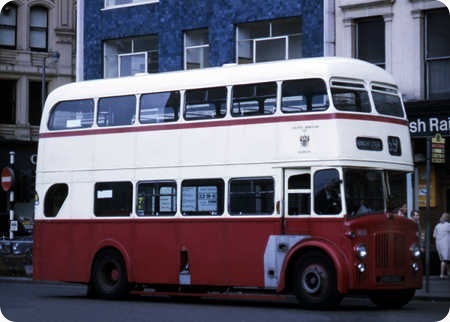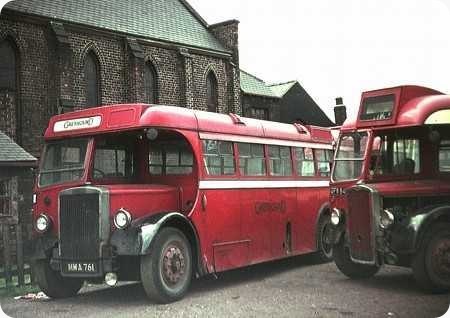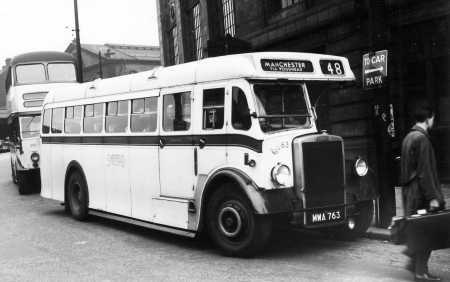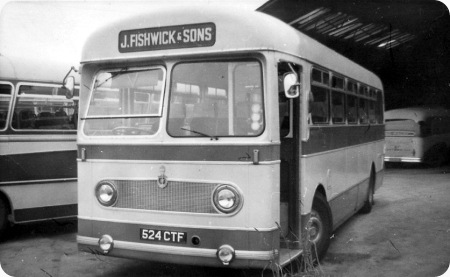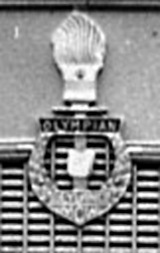Oldham Corporation – Leyland Titan PD2 – PBU 947 – 447
Oldham Corporation
1958
Leyland Titan PD2/30
Roe H37/28R
We don’t seem to have any colour pictures of Oldham buses on the site, so I am submitting these two shots, taken early in PTE days. By the time these pictures were taken, the Oldham livery had been further simplified by the elimination of the red stripe above the lower deck windows. Oldham used a distinctive shade of red that was usually described as "pommard" after the wine of that name. PBU 947, No. 447, was a PD2/30 of the 1958 batch of 24 with Roe bodies, though my understanding is that the seating was H37/28R. Perhaps these buses were reseated at some stage.
NBU 500, No 400, was a member of a batch of 20 PD2/20 delivered in 1957 with Roe H33/27R bodies. The year 1965 was a significant one to Oldham. In that year a Ministry of Transport inspection led to the discovery of major mechanical faults on 97 buses, and the Corporation had to hire in around 45 buses from sympathetic neighbouring municipalities.
Photograph and Copy contributed by Roger Cox
———
04/03/12 – 17:08
Good to see Oldham represented again and with typical vehicles – Roe-bodied Leylands. If these pictures are taken in SELNEC days it must be early 1970 as the fleet very rapidly lost the coat-of-arms and fleetname upstairs, all had lost these by July 1970. 447 got repainted orange and white in January 1971 and was the last Roe-bodied PD2 to be so treated. Unlike the earlier examples it didn’t receive a full overhaul and only lasted until July 1973. 400 was renumbered 5300 in October 1970 but despite running in increasingly shabby pommard and cream it outlasted 447, being withdrawn in March 1974.
Your photos allow the two batches to be contrasted. I could usually identify with some confidence which batch an oncoming vehicle was from but even now I struggle to be able to explain why. One difference visible here which worked as a general rule was the painted ventilators but like all good rules it had exceptions. Other differences were the staircase window which was never fitted to the PBUs but quite a few NBUs lost this feature.
When new the NBUs had pull-down half-drop ventilators which were a disaster. These were replaced by sliders which had a much thinner bottom rail than on the PBUs, making them less conspicuous. You can just about make out the vestigial framework for the half-drops on 400, which remained in situ.
The 59 was a joint Manchester and Oldham service from Manchester via Middleton to Oldham and Shaw. Taking 74 minutes from one end to the other it was certainly Oldham’s longest (in running time) route and I think Manchester’s as well.
David Beilby
———
04/03/12 – 17:26
I rather liked the company name/coat of arms positioned where it is on these buses. I have to say, I don’t think that I’ve ever seen a ‘tin-front’ like these. Was it unique to these vehicles or Roe?
Chris Hebbron
———
05/03/12 – 07:42
The 59 was an incredibly circuitous route which left Manchester in almost the exact opposite direction to Oldham and Shaw which are north east of the city. It headed north west towards Bury along Cheetham Hill Road then turned towards Middleton via Heaton Park and Rhodes. It had almost ‘boxed the compass’ before it got to Middleton. The no. 2 from Stevenson Square to Newhey, which passed Shaw (Wrens Nest) the eventual terminus of the 59 would do the journey in around 40 minutes I would guess.
In fairness to the 59 it was not intended to attract end to end passengers but provided very useful inter-urban links across areas to the north of Manchester.
To answer Chris the unusual ‘tin front’ on these PD2’s was a retro-fit by Oldham after a few years in service. They were delivered with the standard Leyland BMMO front but sometime in the early 1960’s (from memory and I would bow to confirmation on this) the centre grill sections were replaced with the design shown in the photographs. In my view it was a great improvement. I think the replacement section was a glass-fibre moulding but again would welcome a second opinion on this.
The failure by the MOT Inspectors of such a large slice of Oldham’s fleet caused quite a stir at the time and was widely covered in the ordinary (non-transport)press and media. In today’s blame culture I am sure heads would have been called for. I don’t ever recall the press reporting anybody at Oldham ‘falling on his sword’. Does anyone know if there any such actions taken?
Philip Halstead
———
05/03/12 – 07:44
This was Oldham’s own GRP (fibreglass being a trade name) front which they developed. The original one was flat like the standard BMMO grille but I suspect this was not stiff enough so the slight protrusion was added. Oldham were quite active in GRP moulding and also did the side pieces, the design of that varying over the years.
The revised front grille became quite universal. From recollection the last bus with a BMMO grille was 453, withdrawn in 1970. They had been in the minority for some years before then.
David Beilby
———
05/03/12 – 07:45
The "kidney" window in the staircase panel on Roe bodies, which I believe was part of the safety staircase designed by Leeds City Transport general manager Mr. W. Vane Morland in 1935, was a common feature on many Roe bodies up to about 1954 but seemed to fall out of favour after then, so it is a bit of a surprise to see Oldham Corporation still taking them as late as 1957. Does anybody know if these where the last ones built or did other operators have any delivered later?
Eric
———
05/03/12 – 07:46
The tin fronts were Oldham-built replacements for damaged originals, and for my money a great improvement on them. Combined with the Roe body they even make the pommard livery look respectable, which is quite an achievement as it was not generally well-liked.
Peter Williamson
———
05/03/12 – 07:48
Beautiful Roe bodies and a distinctive livery, but I think I preferred their neighbours in blue at Ashton. I think you are correct, Chris – but I think it was an Oldham rather than Roe front.
PS …..see previous black and white post of 451 with standard Leyland tin front!
David Oldfield
———
05/03/12 – 12:33
Eric, I think you’re correct. Sheffield’s 1955 Regent IIIs had the window but the 1957 and 1958 PD2s didn’t and neither didn’t any subsequent Roe bodies.
David Oldfield
———
05/03/12 – 17:53
Leeds first AEC Regent Vs of 1956-57 had the staircase window and were the last Leeds buses delivered with this feature. In the mid fifties all Leeds MCW bodies also had a staircase window this was a narrow slit like vertical affair.
Chris Hough
———
06/03/12 – 08:22
Strange to say, the staircase window reappeared in Sheffield with the front entrance Regent Vs, "Sheffield" Park Royals and then the "Sheffield/PRV standard" 33′ Atlanteans and Fleetlines – but all with tinted glass.
David Oldfield
———
06/03/12 – 12:27
Ah, the tinted glass would be the then modern equivalent of ‘decency boards’ protecting the modesty of Victorian/Edwardian ladies.
The offside straight staircase’d London General/Transport ST’s and later LT’s had glazed windows down the whole length of the offside when built, but, over the years, the rearmost pane was replaced by a painted pane. One imagines voyeurs waiting opposite bus stops for the sight of a trim ankle, or more titillating, a calf! It all seems so amusing nowadays.
Chris Hebbron
———
06/03/12 – 15:22
Am I right in saying in connection with the staircase window was the Roe safety staircase. This had a flat landing halfway up the staircase which in theory would prevent someone rolling in to the road. Did anybody get saved by this?
Philip Carlton
———
07/03/12 – 08:40
The PBU batch of Leyland Titan buses (419-462) were distinctive in that they carried the Leyland winged badge until repainted in 1964/5. The number plates were located higher up the original tin fronts (above air vents) than on earlier batches also. The Leyland/Roe vehicles (429-452) featured decorative beading, painted white, aside the two upper red stripes which resulted in slightly narrower ones than on, for example, the 388-407 (NBU batch)
To the critical eye, another distinctive features were angled front saloon windows, rather than horizontal as on 388-407. The side window vents were polishes aluminium which also made them stand out as mentioned earlier by David Beilby.
D. Butterworth
———
07/03/12 – 15:17
There is always so much to learn on this site. Until Chris Hebbron mentioned the image of a voyeur trying to catch the sight of a calf mounting the stairs of an ST/LT, I had never appreciated that London Transport permitted young farm animals to use the upper saloon.
John Stringer
———
07/03/12 – 16:12
Well, John, if they wanted to smoke they would have to, wouldn’t they?!
Stephen Ford
———
07/03/12 – 16:53
The correct name for the livery is Pommard and Devon Cream, and was introduced in 1966, after the very short lived ‘Blue’ livery experiment with NBU 502 (Fleet No 402).
Mention is made of the positioning of the Fleet Name and Crest. This was done as a cost saving measure to save replacements (of the crest) when accidents occurred to the lower side panels and replacements had to be re-fixed.
I also remember that in the Paint Shop (always an interesting place, supervised by the Foreman Sam Bardsley), that there were replacement lower deck panels painted and varnish ready for quick replacement by the body men. Again this was so vehicles spent less time off the road after lower panel accident damage.
Mention is made of the Ministry of Transport fleet check in 1965.
I started at OCPTD in 1968, as Junior Works Clerk and the ‘Fleet Check’ was still being talked about even then.
Many of the systems which I worked on had been brought about after that, and procedures in the workshops and the Depot had been tightened up.
Philip says ‘did heads roll’ well YES they did, but it was never made public, I will not name names even though it is now 47 years ago, they could still be around.
Stephen Howarth
———
07/03/12 – 16:57
The Roe bodied PBU’s also had a more upright front profile when viewed side on than the NBU’s. Obviously this was necessary to get the extra row of four seats in to give 37 seats on the upper deck against the 33 on the NBU’s.
Philip Halstead
———
08/03/12 – 07:09
Nice ones, John & Stephen F. My comment was even more amusing than I thought!
And, Stephen H, thx for the reason behind the fleet name/crest not being on the lower panels – a sensible variance.
Chris Hebbron
———
09/03/12 – 17:25
Interestingly, around 1970 the Leyland PD2’s reappeared on certain trunk/express routes in all day service having earlier been relegated to other duties in preference to Leyland Atlantean operation.
There are photographs available of 402 – NBU 502 (the blue bus) and 430, PBU 930 on service 9 (Ashton to Rochdale) and Leylands 402 and 437 on the OTS route- Hollinwood Lees/Grotton. The previous years (from 1965 had seen Atlantean operation only on the O/T (27/28) routes, I seem to remember. I have photographs of 461 and forward entranced Leyland PD3 101 on the 98 (Manchester to Waterhead) service around 1970, after a long period dominated by the Atlanteans. Indeed when 131-135 were obtained in February 1966 they were put to work immediately on this route, quickly followed by 136-147 later that year. In April 1970 our local route (21) was converted to OPO with the arrival of dual door Atlanteans 183 to 187. Twelve months later Selnec liveried 188 to 199 arrived and many of these buses could be noted on the route besides the earlier Atlanteans 178 to 182. This marked the end of the PD2’s on the route. For some reason 191 and 192 ended up in Ashton bus depot! Obviously transferred on delivery, but they later appeared in Oldham.
D. Butterworth
———
15/03/12 – 09:30
Further to my previous comments regarding the Leyland Atlanteans which replaced the PD2s on many routes, the numbers allocated were 5183 – 5199 in the SELNEC, (Southern) Fleet allocation, which would have been OLDHAM’S 183 – 199.
D. Butterworth
———
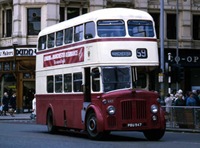 Vehicle reminder shot for this posting
Vehicle reminder shot for this posting
———
23/09/12 – 19:53
I was a driver on Oldham Buses from 1961 & through the 60’s, was quite surprised by photo’s and comments, particularly the 1965 shot after the ministry man came into do his worse. Interestingly, we then drove many buses far worse than our own. The Blue Livery was sponsored by the Egg Marketing Board. Which I believe were given that "Go to work on an Egg" advert printed on the 2 buses with the fleet numbers 401 & 402. The then manager Harry Taylor flirted with idea of the livery but it was unsuccessful. Then the Atlanteans, Selnec etc etc. I moved on to other things and some time later was a HGV & PSV examiner based at Heywood HGV Centre. A local firm had bought 3 PD1 fleet numbers 264 & I think 266 & 268. Not the easiest to teach on. Happy days!
Terry Bailey
Quick links to the - Comments Page - Contact Page - Home Page

